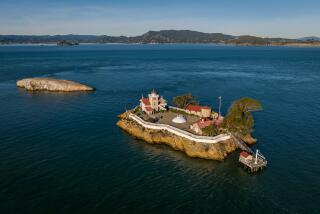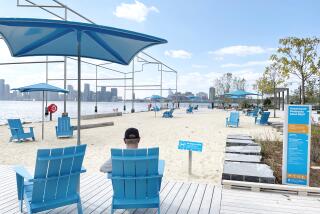N.Y. Vantage Point : Country Isle Will Bask in Liberty Light
NEW YORK — Major crime doesn’t exist. No one can remember a mugging. Spacious three-bedroom apartments with sweeping views of the Statue of Liberty rent for less than $400 a month. Residents enjoy two swimming pools, a nine-hole golf course, a bowling alley and a general store.
Governors Island is a New York City paradox and one of its best kept secrets.
Its red brick buildings, historic houses, spreading shade trees and grassy commons resemble a picturesque New England village.
Judged by the pace and price of the skyscraper neighborhoods that form a backdrop for it, the 178-acre island at the foot of Manhattan, just a five-minute ferry ride from Wall Street, is Small Town, U.S.A.
Near Liberty and Ellis
Manhattan Island aside, Governors Island has also been overshadowed by its other next-door neighbors--Liberty Island, home of the Statue of Liberty, and Ellis Island, for decades the gateway to the American dream.
Governors Island will be at the center of the excitement, however, on Fourth of July weekend. Liberty Island will be in the spotlight during the Statue of Liberty centennial celebration and Governors Island will be both a staging area and the gathering place for the most important spectators--an extraordinary entourage of presidents, diplomats, politicians and show business personalities. For a few days, the island will be a gawker’s delight, a prospect that brings anticipation, excitement and more than a touch of anxiety to many of its residents.
Governors Island, however, is rich in history of its own. It is the oldest military installation in continuous service in the United States. Its fortifications changed hands three times during the Revolutionary War. During the Civil War, it was a prison camp for Confederate soldiers. Nowadays, it is the nation’s largest Coast Guard base and a family-oriented Coast Guard company town.
More than a century ago, a young Army quartermaster lieutenant sent a letter to his wife describing the island’s seasonal pleasures: “We can go to the city at almost all hours of the day in small boats belonging to the government, which ply regularly for the convenience of us all,” wrote Ulysses S. Grant. “But while it keeps so warm, there is but little pleasure in visiting the city. Most of the day we get the benefit of the sea breeze here, while in the city we would get but little of it . . . .”
In many ways, Grant’s observations still are accurate. “At night, you can stand on the sea wall and see everything happening in lower Manhattan and not hear a thing,” said Loren Bullard, a coast guardsman who has been stationed on Governors Island for 14 months. “It’s like TV with the sound off . . . Manhattan is so close and yet so far away.”
Away From Bustle
“You’re able to live in the city and not be in the middle of the fast life out there,” said Richard Schnurr, who is serving his second tour of duty on the island. “You’re in a country setting. I’ve never seen any crime. I feel comfortable walking around the island. It’s only a five-minute hop across the river and you’re back in the fast lane.”
“You have all the benefits of the city, all the great things New York City provides, and you can live in isolation,” said Cmdr. John Murphy, another island resident. “We’re a hidden treasure at the foot of Manhattan.”
With the Fourth of July celebration, however, Governors Island’s tranquility will be broken. Recently, the island’s importance in the celebration was greatly magnified when plans for President Reagan and French President Francois Mitterrand to officiate at the relighting of the refurbished Statue of Liberty were revised.
The presidents originally were to be on an aircraft carrier anchored in the harbor, but instead, they will be on Governor’s Island for the ceremony. Both heads of state will visit the island twice--for the relighting ceremony on July 3, and to review the parade of tall ships that will sail in the harbor on July 4.
Coast Guardsmen and their families whose closest contact with Hollywood has been the island’s single movie theater will be able to mingle with stars such as Gregory Peck, Kenny Rogers, Mikhail Baryshnikov, Bob Hope and Frank Sinatra, as well as with diplomats, Cabinet members and other famous Americans. Guests will include Henry A. Kissinger, Albert Sabin, developer of the oral polio vaccine, and the renowned violinist Itzhak Perlman.
TV Coverage Spot
Network television anchormen Tom Brokaw, Dan Rather and Peter Jennings may cover the centennial celebration from Governors Island.
Part of the island will be turned into a massive stage setting. Tents will be pitched for President Reagan and for the Liberty Weekend corporate sponsors. The island will be decorated with flowers, bunting and flags of all nations. Grandstands facing Lady Liberty will be built for the honored guests.
“What we will get for all this is a front row seat to the historic event,” wrote the Governors Island Gazette, the weekly newspaper. “It will be something we will never forget.”
For some residents, the chance to see the network anchormen is one of the biggest attractions. “Do you think you will be interviewed? It will be interesting to watch ‘Good Morning America’ on our TVs while it is being filmed right outside our living room windows,” wrote the Gazette.
“We will have to rearrange our island to accommodate all our guests,” said Patricia Kramek, whose husband, Capt. Robert E. Kramek, is the island’s unofficial mayor. “ . . . It will be a Coast Guard day as well. We want all our families to come and share it with us. The island will be busy. All the community organizations are deciding whether to sell sweat shirts and baseball caps as fund-raisers.”
For all its small-town atmosphere, however, Governors Island remains a military installation. A good deal of its social life centers around clubs to which rank is the requisite for admission. The island has several Coast Guard training schools and is home base for two 378-foot cutters that go on law-enforcement patrol for weeks at a time. One of them, the Gallatin, was on-scene command ship for initial recovery operations following the loss of the space shuttle Challenger in January.
Country in the City
For some Coast Guard families, the prospect of transferring to New York is frightening at first.
“It’s a big adjustment. When you say New York City, people hold their breath. They are intimidated by the name in many instances,” said Kramek, who now works with her husband to help newcomers to the island feel welcome.
“Compared to Manhattan and New York’s boroughs, it’s a peaceful existence,” said Lt. Cmdr. Thomas Schaad, chief of special services. “But for many of the people on the island, it’s the most packed urban existence they ever had. Most of the Coast Guard is small ships. For most people, it is their first experience with an urban environment and first experience of life on a military reservation.”
“Many have lived in a semi-rural environment, and now they are living right next door to an urban center. A number don’t want to leave (the island). A number don’t get used to the pace of the city. This is as urban an environment as they will ever experience. We are not a big-town outfit.”
To ease the transition, new families are offered walking tours of Manhattan, with instructions on how to find hardware stores, discount pharmacies and shops that sell kitchen utensils. A videotape about the city’s advantages also is available.
Work, School Advantages
Most families adjust and learn to use Manhattan as a resource. Some spouses take jobs in the financial district or attend college in New York City. There are organized trips to the theater, picnics in Central Park, shopping tours and other activities. A city elementary school operates on the island, but most older students go to high school in Manhattan.
Most newcomers also find that Governors Island offers many of suburbia’s advantages without its discomforts. It is just 500 yards from Wall Street, yet far away in terms of the pace of living.
“My son is going off-island all by himself to run an errand and I don’t have to commute with him by car,” Patricia Kramek said. “My daughter walks to her guitar lessons. It cuts down on an enormous amount of car-pooling and commuting. There is a clinic on the island that handles routine medical care. One of the major advantages we have is that the men walk to work . . . We have one car, and we fill up the gas tank once a month.”
There are other advantages. Life is leisurely, for the most part, and the island offers a protective environment for children. It is the kind of place where youngsters have Easter egg rolls, where Coast Guardsmen take pleasure in photographing New York’s spectacular skyline at night. Residents have a boat club, ceramics classes and sports programs. The speed limit is 15 m.p.h.
The island has rich and varied history. It has been a pasture, tobacco plantation, race track, logging camp, orchard, quarantine station and military post. At one time it had a polo field. In the late 1920s, New York City wanted to build an airport on the island, but the Army erected a huge barracks in the middle of the proposed runway area, thwarting the plan.
The purchase of Governors Island was New York’s other big bargain. Historians write regularly of Peter Minuit buying Manhattan Island from the Indians in 1626 for 60 guilders worth of cloth, hatchets, beads and other trinkets. They ignore Wouter Van Twiller’s success. In 1637, Van Twiller, the Dutch governor, bought Governors Island from the Indians for just two ax heads, one string of beads and a handful of nails.
Reserved for Governors
Under English rule, the island was set aside as the home of the New York governor. Edward Hyde, a cousin of Queen Anne who was governor from 1702 to 1708, built a handsome mansion on the island and was fond of giving dinner parties in his new home. According to historians, he also was fond of dressing up in women’s clothing and parading along the ramparts of the fort, for all to see.
In 1710, a convoy of Palatine refugees arrived to be quarantined on the island before settling farther up the Hudson River. A monument on Governors Island memorializes one of their number--John Peter Zenger, who became publisher of the New York Weekly Journal and a champion of freedom of the press.
The island has 18th-Century houses with manicured lawns. Its northern sector is dominated by Ft. Jay, built in 1798. The entrance to the harbor is guarded by Castle Williams, a circular fort, built in 1811, that housed Confederate prisoners during the Civil War. On June 30, 1966, the Coast Guard took over from the Army and made the island the largest U.S. Coast Guard base.
Because of Coast Guard transfer policies, at least a quarter of the island’s population changes each year. But friendships last.
“When you leave here, you will run into someone else who was stationed on Governors Island,” said Lt. Cmdr. Marc Wolfson, the island’s public information officer.
“You get a large circle of friends. People know who you are,” added Bullard. “ . . . There are no strangers on this island.”
More to Read
Sign up for The Wild
We’ll help you find the best places to hike, bike and run, as well as the perfect silent spots for meditation and yoga.
You may occasionally receive promotional content from the Los Angeles Times.






